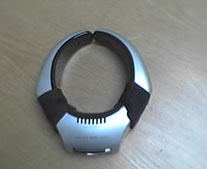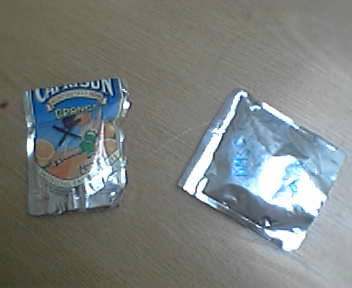|
You know the old saying: "Everybody's talking about the weather, but no
one's doing anything about it!"
Well, I decided that rather than accept the unpleasant effects of the heat,
I'd develop a heat management strategy for personal comfort.
Evaporative cooling
| Temp ºF |
% Humid |
Dewpoint ºF |
| 80 |
20 |
32 |
| 80 |
50 |
59 |
| 80 |
70 |
69 |
| 80 |
90 |
77 |
| 90 |
20 |
41 |
| 90 |
50 |
68 |
| 90 |
70 |
78 |
| 90 |
90 |
86 |
| 100 |
20 |
49 |
| 100 |
50 |
76 |
| 100 |
70 |
87 |
| 100 |
90 |
96 |
| 105 |
20 |
53 |
| 105 |
50 |
81 |
| 105 |
70 |
92 |
| 105 |
90 |
101 |
|
Cool-Tie: Most everyone is familiar with the gel crystal bandanas which you
soak in water and put around your neck. These work by evaporative cooling
and can cool up to the "dewpoint". On a dry day, that could be
many degrees below the air temperature.
 |
 |
Sharper Image Evaporative
Cooler: This thing goes around your neck and contains metal plates
that transfer heat away from your skin. Inside, there are sponges
(that you wet) and a little fan and ducts to cause evaporation from the
sponges. |
 |
Coolmax: This is a fabric made of
synthetic fibers by DuPont that are
engineered with microscopic channels along the surface of each fiber.
These channels use capillary action to "wick" the sweat away from your skin.
Also, since the fibers don't absorb any water, evaporation is faster than with
cotton. Garments made with coolmax include underwear, socks,
t-shirts, but I prefer the bandanas (or dew-rags) to absorb, dry, and cool the sweat from my
head. |
Phase-change cooling
| When a material changes from solid to liquid (melts), it absorbs extra energy
beyond the mere energy of the temperature change. This has the effect of
cooling the surrounding area. However, materials that melt at 0º C
(32ºF) like ice are a little too cold to be comfortable and condensation that
forms (as water vapor in the air also liquifies) is undesirable. But
substances that freeze or melt between 18-35ºC (65 - 95ºF) might better meet
those objectives. I have experimented with the following substances: |
 |
- Hexadecane (C16H34)
- Melting Point 18º C (65ºF). Somewhat dangerous, this component
of kerosene and diesel fuel absorbs a lot of heat during its phase change.
Obviously, it will freeze solid in a refrigerator (which is usually kept
around 40ºF). The liquid penetrated plastic bags and even a
6-mil plastic pouch, so I decided to put it into a sealed laminated foil
pouch (which formerly held a "Capri Sun" drink). This was sealed
with an iron for several seconds.
- Usually, after chilling the pouch, I place it on my head under a bandana -- at 65ºF, it's
quite comfortable and lasts over an hour (before the solid is completely
melted).
-
|
- Dimethyl Sulfoxide (DMSO)
- Melting Point 18º C (65ºF). A popular horse-liniment and
folk-remedy, DMSO is really cheap and seems to work almost as well as
hexadecane. It was almost contained in the 6-mil plastic pouch, my
seal was insecure and eventually leaked. Of course, the Capri
Sun laminated foil pouch kept it very secure.
-
|
- Cocoa Butter
- Melting Point 34ºC (93ºF). Obviously, this requires no
refrigeration to "recharge" because normally at room temperature it is a
solid. However, placed against the skin, it does melt and absorb
heat. It's not as pleasant as a 65º pouch (which feels like personal
air conditioning!), but it will keep the skin at a comfortable
temperature. In a laminated foil pouch (shaped as a headband),
creases caused the
pouch to crack Although it is very safe, it has a
"chocolate-y" odor that quickly becomes nauseating. I am
investigating the usage of a deodorized cocoa butter.
|
|